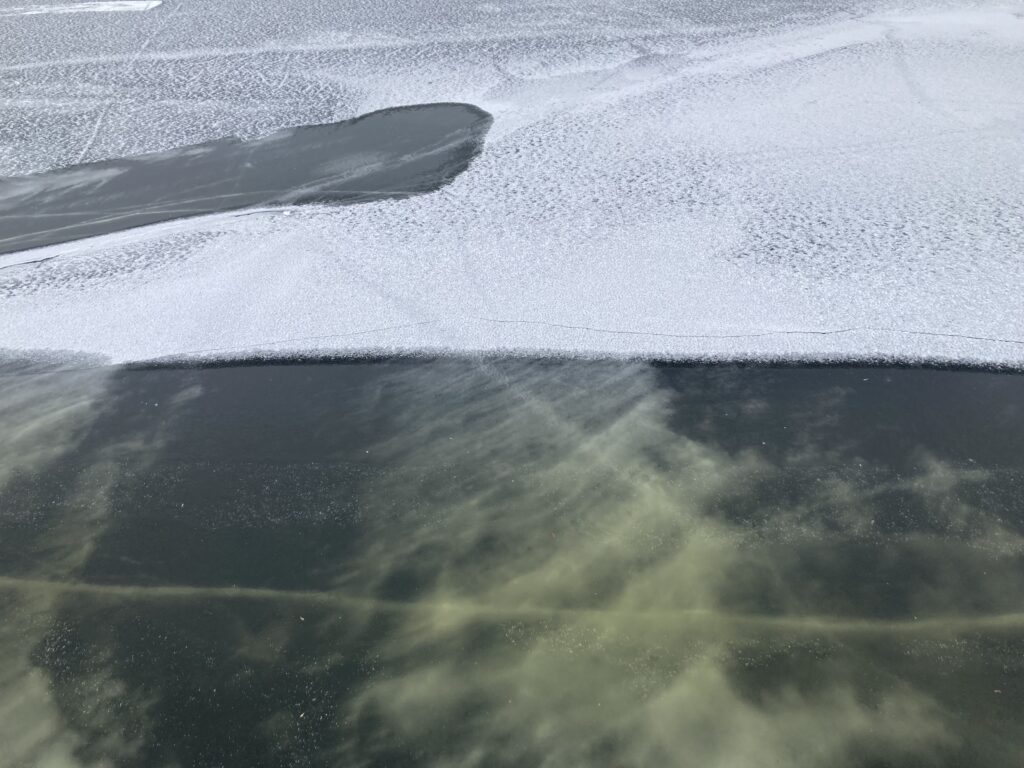3.2 miles
locks and dam no. 1 loop
34 degrees
Breezy. Wind coming from the north. Sunny, too. Lots of shadows. Today’s run wasn’t effortless but it wasn’t hard either. Somewhere in-between. Listened to my “Remember to Forget” playlist for the last day of the month. Even with my headphones in, I could hear kids on the playground across the road, some hikers talking on the trail below.
Listening to the songs, I thought about the tenderness of remembering and the satisfaction of forgetting. Also thought about how we all remember things differently, and most of us inaccurately.
10 Things
- the river was a patchwork of white and gray
- only a few lumps of snow scattered on the grass and the trail
- slick puddles
- a sagging fence, casting a crooked and forlorn shadow
- BLUE! sky
- a few of the benches were occupied — at least 2
- my favorite bench, above the “edge of the world” was empty, so was the one near folwell
- ran on all of the walking paths — clear!
- the sparkle of broken glass in a pile of leaves on the street in front of a neighbor’s house
- a chain link fence below on the winchell trail, illuminated by the sun, on the edge, at the part of the trail that is slowly sliding into the gorge (the rubbled asphalt stretch just past 38th street)
before the run
These evenings of long light
Must be high festival to them. It’s the time
When the light seems tender in the needles
Of the pine, the shimmer of the aspen leaves
Seems kindly on the cliff face, gleams
On the patches and gullies of snow summer
Hasn’t touched yet.
(from The Creek at Shirley Canyon/ Robert Haas)
Reading this description of light in this beautiful poem, I’m reminded of Wednesday’s afternoon light. Stepping out on the deck around 4, I gasped as I noticed the light on the bare trees, glowing a soft green. An olive green, Scott thought. It seemed to be offering a glimpse of the future when winter was over. How should I describe that light? Not tender — dazzling? a show-stopper? But maybe tender, too. The light was soft on the trees — bathing them in light? — coaxing out them of their dreamed of leaves in the forms of the green glow.
And the creek is flush
With life, streams of snow melt cascading down
The glacial spills of granite in a turbulence
The ouzel, picking off insects in the spray,
Seems thrilled by, water on water funneling,
Foam on foam, existence pouring out
Its one meaning, which is flow.
(from The Creek at Shirley Canyon/ Robert Haas)
The glacial spills of granite? Water on water funneling? Existence’s one meaning: flow? Wow! I love this description of water.
Read, We Could Just Gaga Our Grammar, this morning and it got me thinking that I need to do some more strange, fun, playful experiments on here. Return to the erasures? Sentence scrambling? Pick something off of Meyer’s Please Add to this List list?
Encountered, Lullaby of Jazz Land: A Found Poem Composed of Titles from the American Songbook, and am thinking of doing something with the titles or lyrics from my Remember to Forget playlist.
Turned randomly to a page in The Braille Encyclopedia and read “Body”.
The rest of the body works to compensate for what the eye can no longer do.
The Braille Encyclopedia/ Naomi Cohn
Cohn discusses a sore neck and back, muscle spasms, headaches. Do I feel any of these things? The occasional headache. Starting these sentences, I had forgotten about the dizziness, then I remembered when I felt it — the world suddenly swimming for a moment as I tried to read and write in this entry.
Then she mentions feeling very tired —
A kind of tired that feels like most of my trillions of mitochondria have decided they’ve cooked their last energy-meal, turned off the stove, hung up their aprons, kicked off their pinching shoes, and gone to lie down somewhere. For a very long time.
The Braille Encyclopedia/ Naomi Cohn
I feel tired often — maybe not as tired as Cohn. I take naps, or fall asleep mid-sentence. I have the luxury of measuring my efforts, (and lowering my expectations), not doing things that are too draining too often. Shopping is draining, especially grocery shopping. A few weeks ago, I had to stop at the end of the aisle, hang onto the cart, and close my eyes for a minute. Too many things I couldn’t quite see, lights that were too bright. Deep breaths. This used to make me anxious, but now, with the help of lexapro and the understanding that this dizziness is caused by an uncertain and overworked brain, I don’t worry as much.
after the run
After discovering James Longenbach’s poem, “In the Village,” earlier this month, I requested his collection Seafarer from the library. Here’s part 4:
from In the Village/ James Longenbach
Of ghosts pursued, forgotten, sought new—
Everywhere I go
The trees are full of them.
From trees come books, that, when they open,
Lead you to expect a person
On the other side:
One hand having pulled
The doorknob
Toward him, the other
Held out, open,
Beckoning
You forward
